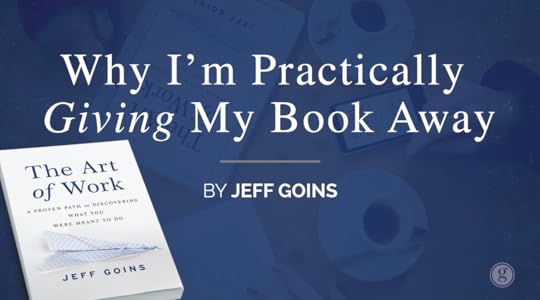Jeff Goins's Blog, page 57
March 6, 2015
Why Most People Aren’t Satisfied with Work & What to Do about It
Have you ever wondered what you were supposed to do with your life? Or felt like you were somehow missing out on “something more?” Turns out, that’s not such a unique feeling.
A recent Gallup poll revealed that 87% of the global workforce is not engaged with work. In other words, employees are either not motivated or just plain unhappy about their jobs.
To me, that sounds like a problem.
For years, I felt just okay about my job. I didn’t hate it, but I didn’t love it. And I struggled to figure out what to do with my life. Did I have a calling? Was I meant to do something? Or was I just not one of the special ones?
Then I had a conversation with a friend where I told him I didn’t have a dream. He didn’t believe me. In fact, he insisted that my dream was to write. And as soon as he said it, I agreed. I wanted to be a writer.
“But Jeff,” my friend Paul said. “You don’t have to want to be a writer. You are a writer. You just need to write.”
Two years later, I quit my job and pursued my dream. And in doing so, I learned a crucial lesson: activity follows identity. Before you can do something with your life, you have to discover who you are.
In writing The Art of Work, I interviewed hundreds of people who were doing meaningful work. They all seemed to say the same thing: “I didn’t know what I was supposed to do. It took time to figure it out who I was.” That was a message I could relate to.
These people taught me three lessons about work:
Everything is practice. What often feels like a setback or failure is really preparation for what’s to come. Don’t neglect the chance to learn where you are.
Discovery is a process, not a moment. Don’t wait until you’re ready. Act, anyway. Clarity comes with action.
A calling is not just a job. It spans your whole life. You’re not done until you’re dead.
This began as a book about how I became a full-time writer, but as I started diving deeper into the material and stories it became so much more than that. This is a guide that will help you:
Make sense of your life.
Understand your place in the world.
Take the next step in finding your calling.
If you pre-order it before Mar. 23, you’re going to get the book for free. All you have to pay is shipping and handling. On top of that, you’ll get $250 in bonuses, including a free online course, downloadable workbook, and access to me.
And if you order today, you’ll get an advance digital copy of the book so you can start reading before the book comes out!
Download the Introduction
Pre-order The Art of Work Now
Do you struggle with trying to figure out what you were meant to do? Share in the comments.
March 4, 2015
045: An In-Depth Look at Cowriting: Interview with Frank Viola and Mary DeMuth [Podcast]
Writing is often thought of as a solitary activity; something that happens in isolation. But that’s not always the case. Sometimes creativity happens best when you collaborate.
This week on The Portfolio Life I have the privilege of interviewing Frank Viola and Mary DeMuth. Frank and Mary are both successful writers who have each written dozens of books. I’ve admired them both for a long time — I followed them even before I was a writer myself.
Listen in as we talk about the cowriting process and their new book The Day I Met Jesus.
Listen to the podcast
To listen to the show, click the player below. (If you’re reading this via email, click here).
You can also listen at iTunes or on Stitcher.
About the book
Together, Frank and Mary have cowritten a new book titled The Day I Met Jesus. This biblical narrative is a blend of autobiographical fiction combined with nonfiction to tie in practical application. As far as I know, there are no other books out there like this.
Cowriting comes with many potential challenges as well as benefits. And in this podcast we talk about both the upside and downside. Cowriting allows an author to partner with another writer who has a different platform. This involves teamwork and clear communication.
The cowriting approach can work well for those who share a writing chemistry. But what if the authors have a completely different writing pace? That’s one challenge we discuss in this episode.
Show highlights
In this episode we discuss:
The benefits and challenges of cowriting.
The strategy behind their book launch.
The value of partnering with an author who has a different platform.
Bingers and chippers — the two types of writing paces.
Resources
Go to TheDayIMetJesus.com to find out how you can order the book at a discounted rate and get in on some exclusives bonuses. The bonuses are available this week only.
What are some of the benefits you find in collaborating on a project? Share in the comments.
March 2, 2015
Why Most Book Trailers Are Awful & How Yours Can Be Different
My first book trailer was awful. The second one was great. And the third was even better. What made the difference? The way we approached the process.
For my first book, I met with a video crew and stared awkwardly into a camera for five minutes, talking about myself. I didn’t have any experience as a speaker and didn’t understand what a good trailer was supposed to do.
Not surprisingly, it flopped.
With the second trailer, I didn’t do any of that. My publisher provided a top-notch video editor, I wrote a compelling script, and we kept it short. It went over like gangbusters. Here’s why:
We made it about the reader, not the author. In fact, I wasn’t even in it, which was good. Every person wants to believe they’re the hero of their own story, so we spoke to that desire.
We talked about the idea behind the book, not the book itself. Most people don’t want to buy books. They buy solutions to their problems, so we addressed a universal struggle.
We didn’t tell people to read the book, we invited them into a movement. Everyone wants to feel like they’re a part of something important, something bigger than themselves, so we piqued their interest with an invitation. If they buy into the movement, they’ll buy the book.
Most book trailers aren’t that good. Okay, that’s generous. Most book trailers are lame. They’re boring and insulting to the reader. Just like a good book cover, a trailer should respect its audience.
Why am I sharing this?
Because I love books and hate seeing them represented so poorly. Which is why I was excited to see this trailer for my latest book. I think it satisfies all three of the criteria above, but I’ll let you judge for yourself.
And whether you ever produce a book trailer or not, remember that successful marketing is all about making others the hero, promoting a worthy idea instead of selling a product, and inviting the audience into a movement.
Don’t forget: there are only three weeks left to pre-order my new book and get it for free when you pay $6.99 in shipping. If you do it today, you get access to a private community, workbook, and free online course. Get started here.
What do you think makes for a good book or movie trailer? Share in the comments.
February 27, 2015
The Complicated But Beautiful Process of Finding Your Calling
When people used to ask me how I became a full-time writer, I struggled to give an intelligent answer. How do you chase a dream? It’s complicated.

Photo Credit: gail m tang via Compfight cc
My last day of working a day job also happened to be my thirtieth birthday, which made it a milestone in many ways. The truth, though, is the day itself, as climactic as it was, was less significant than the process it took to get there.
For years, I wanted to write. I kept a blog and wrote for magazines but never took it too seriously. When Ashley and I decided to have a baby, all that changed. We couldn’t live off just my income and she wanted to stay home to be a mom, so I became determined to make that happen.
For two years, I stayed up late and got up early, squeezing in a few extra minutes of writing whenever I could. I didn’t quite know what I was doing or even how I would do it, but I just kept writing and sharing my work and trying to grow an audience. I knew that if I could get people to pay attention to my work, I’d find a way to make a living off my words.
Then after 18 months of hustle, a few opportunities emerged. Over the course of six months, I launched two books (one self-published and another traditionally published), started speaking at conferences, and released an online course. By the end of the year, we tripled our income.
I was so focused on the goal of replacing Ashley’s income that I wasn’t paying attention to how much momentum was building.
It took a wake-up call from a friend for me to realize what was really happening.
My wake-up call
“What’s happened to you is rare,” my friend Mark said to me one day while we were discussing about whether or not I should quit my job. ”Nobody saw it coming. I know you, Jeff, and I didn’t see it coming. You have to consider the possibility that if you don’t do this, it might be an act of disobedience to God.”
After that conversation, I stopped thinking of this as an opportunity or even a dream and replaced it with a much weightier word: calling. And a month later, I met with my boss to tell him what I had been working through. I said I was afraid of disappointing him.
“Jeff,” he said, smiling. “I’m not disappointed. I’m proud. The truth is I’ve been waiting for this conversation. I think it’s time.”
So on March 31, I worked my last day at the only real job I ever had, turned 30, and began my career as a professional writer.
But that’s not the whole story…
This is the story I tell when people ask me how I got here. But there’s so much more to it. Like the seven years of learning about marketing and business while working at a nonprofit. Or the unintentional practice I got in college as a writing tutor. Or how my mom used to read me the dictionary on long road trips.
The experience of finding your calling is both mysterious and practical. It takes effort but also seems to happen to you at times. What I’ve come to understand is that finding your purpose is more of a path than a plan: it involves unexpected twists and turns that at times look like accidents but actually are a part of the process.
Everyone, I think, is searching for a purpose, for something to satisfy their deepest desires. I believe that “something” is a calling. What does that mean? To me, a calling means the reason you were born. It’s that thing you were meant to do.
And finding it is never as simple or as easy as we’d like it to be.
What I learned
When I began working on my new book The Art of Work, I thought I knew what the process of finding your calling looked like, but what I learned surprised me.
Discovering your life’s purpose, it turns out, isn’t quite so simple. The journey looks different for everyone, but there are also common themes that tend to appear.
So I had a thought: What if what happened to me wasn’t so rare? What if everyone has a calling? So for a year and a half, I’ve been trying to answer that question. And after interviewing hundreds of people, reading tons of biographies, and reflecting more honestly on my own story, here’s what I’ve learned:
You can’t do this on your own. You need help. Mark was one of many guides who helped me understand my life and what to do with it.
You’ll have to practice. It won’t be easy. If you want to discover your life’s work, you’ll have to fight for it.
You won’t “just know.” Discovery happens in stages and clarity will come with action. The most important thing you can do is take the next step.
In the book, I feature stories of everyday people whose names you probably won’t recognize, and that was intentional. I wanted to communicate that calling is not something for “chose ones,” but for everyone. And in these seemingly ordinary stories, I think we understand our own lives a little better.
At times, I think we all feel like our own stories are a little too ordinary for our liking. But what if in that ordinariness, there was something extraordinary we could tap into? That’s the idea of the book.
Get the book practically for free
I hope The Art of Work helps you make sense of your life, gain a greater understanding of your purpose, and know what to do next. Don’t forget: for a limited time you can get the book for free when you pre-order it. Just pay shipping.
Click Here to Pre-order My New Book
What was a time when you discovered something about yourself that surprised you? Share in the comments.
February 25, 2015
044: What To Do When It’s Your Turn: Interview with Seth Godin [Podcast]
When it’s your turn, the most important thing you can do is realize it’s your turn. Marketers have led us to believe we need to wait to be picked or approved, but that’s simply not true.
This week on The Portfolio Life I’m joined once again by a role model of mine: Seth Godin. In this new episode, Seth and I talk about his new book What To Do When It’s Your Turn, the invention of writer’s block, and what you can do to change things for the better.
I also ask Seth a question I’ve always wanted to ask him, one of the world’s most popular bloggers: how does he write? The answer might surprise you.
Listen to the podcast
To listen to the show, click the player below. (If you’re reading this via email, click here).
You can also listen at iTunes or on Stitcher.
More about the new book
The excuse for this interview was Seth’s new book, but we ended up talking about a lot more than just that. Honestly, I asked him every question I’ve ever wanted to ask and even got an inside look at how he approaches his career as a writer, entrepreneur, and marketer. It was fascinating.
When deciding what kind of book to write, like the last one he just published, Seth approaches the craft uniquely. Rather than looking at what book he thinks he could sell, he decides which book to write based on whether or not he cares enough about it to devote a year of his life to its making.
Seth asks himself, “What do I need to read?” Then he makes the assumption that there are other people like him who need to read that book, as well. This time, it meant crafting a book that’s more like a magazine than a book. And he released it in a pretty remarkable way (find out how in this week’s episode).
Highlights from the show
You have to write the book that wants to be written.
The people who are doing good writing almost never have time to complain about how unfair things are.
The magic of writing is that we all get the same 26 letters. It’s what we do with them that matters.
The secret to non-fiction writing is you have to write stuff that almost everyone says is insane, stupid, wrong, or ill-informed. Otherwise we’ve already read it.
Resources mentioned in the show
What to Do When It’s Your Turn (And It’s Always Your Turn) by Seth Godin
“Writer’s Block and the Drip”
Seth’s blog
The first time Seth appeared on the Portfolio Life
Because I love his work so much, I’m also giving away one copy of each of Seth Godin’s 18 books to a lucky winner. Go here for more information.
What’s stopping you from writing your book that wants to be written? Share in the comments.
February 23, 2015
The Kind of Platform You Should Be Building
A couple years ago, I left the country. With 19 other people, I spent five days traveling through Guatemala, serving local NGOs that were improving the lives of those living in poverty.
Halfway through the trip, I looked around in awe. We 20 strangers gathered together for a purpose bigger than ourselves to do work that wasn’t about us, leaving each person changed through the process, including me.
How did all this happen? One word: Platform.
This group of people had connected to each other and to me through a blog, and then a book that I wrote a few years ago. And now we were in another country, doing things we never would have imagined: sleeping in hostels; taking cold showers; touring the city dump and embracing the sick, diseased, and downtrodden. All because of a platform.
The experience rocked me to my core and gave me the perspective I needed to appreciate what a platform is really supposed to be about.
What does this mean for you?
Everyone has something to say. I believe that with all my heart. And in a noisy world full of distraction, we need a way to way to get heard, a way that is not completely about us. That’s called a platform.
A platform is exactly what it sounds like: It’s a stage on which we stand to share our message. It’s not an end to itself (i.e. “Hey, look at me and how great I am!”). But rather, it’s a means to an end.
We don’t build a platform so the world thinks much of us. We build a platform so we can change the world.
Or at least, that’s why we should.
For a long time, I didn’t understand this. I had a blog nobody read. Nobody was changed by my word, and no one thanked me for my words. After years of failure, I threw my hands up in frustration and wondered, What was I doing wrong?
Don’t make it all about you
People are smarter than most marketers think. They can tell when you’re trying too hard or when you’re presenting a cleverly-presented pitch that helps you more than it does them. And that’s what I was doing with my first foray into social media.
I was making it all about me.
My blog was about getting other people to like me. It was about attention and accolades. I would chase fame, no matter what the cost, sacrifice or compromise anything just to be known. It was pathetic, but I couldn’t seem to help myself. And no surprise: the blog failed.
It wasn’t until I quit my blog and started over that I learned the ever-important lesson of focusing the attention away from myself. And that’s when things began to change. Turns out, when you make your platform about other people, they’ll make it about you.
And when you build an audience sharing a message that matters, you can change the world.
Here’s your challenge
We all are building a legacy. With our words and actions, we are making our mark on the world, one way or another. So why not create a legacy that will endure, one that gives more than it takes?
Whatever stage you’re building — be it a blog, a business, or a butcher’s shop (sorry, just had to keep with the alliteration) — make it about someone else.
You don’t have to be huge; you just have to be helpful.
Ask questions, offer solutions, see what a difference you can make. Because the truth is we don’t find our purpose in life by looking in the mirror, staring at ourselves. We find it by looking out the window at a world in need.
So, dear friends, it’s time to open up our eyes and decide what kind of platform we ought to be building. If you need help getting started, check out my free guide to launching a blog. Just click the link below (it’ll take you three a step-by-step tutorial on launching a self-hosted WordPress blog on any budget).
Click here to learn how to launch a blog that can change the world.
And if you already have a blog, it’s time to share! Leave a comment below with a link to a blog post you’re proud of.
How are you using your message to help others? Share a recent blog post in the comments.
February 20, 2015
Every Story of Success Is a Story of Community (Plus a Chance to Join My Media Team)
When I wrote my latest book, I did it all wrong. It was all my ideas and experience and when the thing was finished, I didn’t like it very much.

February 18, 2015
043: The Power of Free: How You Can Profit from Giving Away Your Work [Podcast]
Since the dawn of time, human beings have felt the need to share — from food to art. Sharing is part of the human condition. A person who does not share is not only selfish, but bitter and alone.
–Paulo Coelho
You have something to say, but the world just won’t listen. What’re you doing wrong? Maybe you’re being too stingy. If you have a message to share and no one’s listening, the best thing you could do is give some of it away for free.
![043: The Power of Free [Podcast]](https://i.gr-assets.com/images/S/compressed.photo.goodreads.com/hostedimages/1424317619i/13745584._SX540_.png)
The best way to get someone’s attention is to be generous. Giving your work away for free is something I’ve talked about for years. But it also comes with its share of challenges.
In this week’s episode of The Portfolio Life my co-host Andy Traub and I talk about the obstacles of “free” and offer practical tips on how to overcome them.
To distill the entire episode down to a single takeaway, it would be this: Being generous is a great way to get attention. But when everything’s free, nobody values what you do. [Tweet]
Listen to the podcast
To listen to the show, click the player below (if viewing this in email, click here)
You can also download it at iTunes or on Stitcher.
How free can lead to more sales
Being surprisingly generous is a great way to engage your audience and build trust with a tribe. In fact, I’m modeling this right now with giving paperback copies of my book for a limited time. I believe in this stuff.
People often ask me if being too generous will water down what you do or undermine the value of your offering. Honestly, that’s the wrong question. The biggest enemy of getting your work to spread isn’t people ripping you off. It’s people not knowing who you are.
For example, take Paulo Coelho, author of The Alchemist, one of the best-selling books of all time. The book wasn’t an instant success. In fact, the publisher told him it wouldn’t amount to much. So how did he end up selling over 65 million copies?
When his publisher dropped him, Coelho decided to forgo traditional marketing and began promoting his book in less conventional ways. Taking efforts into his own hands, he began “knocking on doors” and within a few years, the book went from selling a few thousand copies a year to millions.
So what made the difference?
According to the author, it was giving his book away for free on the Internet — first by publishing a Russian translation on his own website and allowing people to download it for free, then by sharing it on other file-sharing sites.
And guess what? It worked.
Coelho is a big proponent of radical generosity, especially with books, music, and art. He thinks all works of art ought to be shared, and if you do this enough, the work will spread and people will want to pay for it. I agree.
Tips on being strategically generous
Give somebody something short, shareable, and easy to consume in one or two sittings. For writers, I recommend crafting a manifesto.
If you want attention, you are going to have to create a “WOW product.” But creating “wow” isn’t just giving somebody something that’s great. It means going above what’s expected.
Don’t give everything away for free or it waters down the offering. Offer something that’s valuable by making it rare.
Resources mentioned
“The How of Wow” by Michael Hyatt
Free: How Today’s Smartest Businesses Profit by Giving Something for Nothing by Chris Anderson (affiliate link)
Why Free Is Your Best Marketing Strategy
Best-selling Author Turns Piracy into Profit
Pirate Coelho
If this episode was helpful to you, please share it (it is free, after all) with others who may benefit from it. Also, I’d appreciate an honest review on iTunes.
As part of practicing what I preach, my new book The Art of Work is available for a limited time for free. This is a book about finding your calling and is full of stories of how others found their life’s work. Just cover the flat-rate shipping and handling and you’ll get a free copy of the book at ArtofWorkBook.com
How can you apply the concept of giving something for free to helping your work spread? Share in the comments.
February 16, 2015
Three Things Most People Don’t Know About Book Cover Design
A book designer gives form to content but also manages a balance between the two.
–Chip Kidd
So far, I’ve written four books: three traditionally published and one self-published. Every time, I’ve been intimately involved in the design process, as I think every author should be.

I know this is the digital age and all, and here I am telling you these things on a blog, but I still prefer print books. I love the typography and interior design, how the use of artwork can tell a story.
Most of all, though, I love what a book cover communicates. Books don’t just speak with words. They also speak with the way they are designed.
Unfortunately, a lot of authors, and sometimes publishers, get this wrong. In fact, we may be facing a problem in the world of publishing, as we are seeing more people take ownership of a process they don’t fully understand.
Many self-published authors and indie publishers (which I celebrate, by the way) thinking that a good book design is just about having a pretty cover. It’s not.
I’m no expert, but ever since I became a marketing director of a nonprofit years ago and now run my own online business, I’ve made it my business to become a student of design — an amateur aficionado, if you will. So here’s what I know.
The cardinal rule of book design
According to renowned book designer Chip Kidd (who designed the cover to Jurassic Park and many others), good book design is about giving form to content but also appreciating the balance between the two.
In his quirky Ted talk, Kidd explains that on his first day of graphic design class in school, the teacher drew a picture of an apple, then wrote the word Apple and said: “Listen up. You either say this,” pointing to the word apple, “or you can show this,” pointing to the picture of the apple.
“But you don’t do this,” he said, pointing to a picture of an apple with the word Apple beneath it. “Because this is treating your audience like a moron. And they deserve better.”
In other words, you can show or tell, but don’t do both. Don’t treat readers like they’re stupid. This is the first rule of book design.
Respecting your audience
The second rule is to know and respect your audience.
Books are not created in a vacuum. They are not merely a manifestation of the author’s creativity. The content needs a form, and the form will influence the way the content is consumed.
All art has an audience, and books are no different. Good book design, then, is not just an expression of the story or idea behind a book. It is a piece of marketing. And as such, it needs to matter to the people it was intended before.
Chip Kidd says as a book designer, he has a responsibility to three groups of people:
The reader
The publisher
The author
The ultimate goal of a good book design is to get people to respond. For the reader, you want people to say, “Wow! I need to read that.” For the publisher, you want them to say, “This is something we can print.” And for the author, you want them to say, “Yes! This expresses my idea better than I could!”
How do you do that?
You make something that matters not just to you, but also to the audience.
My thoughts
So let’s summarize. Here are three things people often get wrong with book covers:
Book design is about giving form to content but understanding the balance between the two.
A book cover should not show and tell. Don’t treat people like morons.
Creativity doesn’t happen in a vacuum. Respect your audience and understand your responsibilities as a creator/designer.
Personally, I think good design is a little counterintuitive. A book cover should make you think, should make you puzzle a little, wondering, “Now what’s that about?” But be careful, because if you do this too much, you confuse the reader. If you do it too little, you will bore the people you are supposed to be wowing.
Good books don’t just tell you what you want to hear. Good books provoke. They make you think. And so should their covers.
This was the process I went through as I worked with my publisher to design my latest book cover, and it’s the process I’ve experienced every time I’ve published a book. I think it works quite well and will hopefully help you make something that matters.
To see what we ended up with for my latest book cover, go here. And be sure to watch the video below.
What kind of book cover catches your eye? Share in the comments.
February 13, 2015
Why I’m Practically Giving My Book Away
“You’re giving your book away?” My wife asked the other night in shock. Yep. And that’s not so crazy as it sounds.
I’ve long held the belief that an author’s greatest enemy isn’t people ripping off her work. It’s anonymity.
In other words, if you’re an artist, you should be more scared of people not knowing who you are or what you do than you should be worried about how much money you can make off your work.
The strategy of free, from a marketing perspective, works. Here’s why.
1. Free is a great way to get people’s attention.
The other day I was at the mall returning a pair of shoes that didn’t fit. While I was there, I passed through the food court and was greeted by eager fast food vendors hawking free samples. And guess what? I stopped to try some delicious bit sized gyros.
It’s hard to get people to care about you when you’re just one more voice in a crowded food court. But unexpected generosity is one of the best ways for people to discover your work, your art, your product. (Click here to tweet that.)
2. Once people are paying attention to you, some of them will want to pay you.
I learned that lesson first from my blog. After a year of writing every day, giving away nearly a decade’s worth of writing and marketing experience, people starting asking me via email if they could buy something from me.
And so I let them.
Here’s the lesson. When you attract a large enough audience, some — but definitely not all — will pull out their checkbooks and want to reciprocate your generosity.
This isn’t the reason you create, but it’s a beautiful byproduct of the process that allows an artist to make a living.
3. The hardest part of marketing is getting people to talk.
The reason why any of us buy anything is because most likely we heard someone we trust recommend something we want.
When I launched my first trade book, I pushed the publisher to give away a copy of the book to nearly everyone I could think of. That ended up being at least 300-400 books, maybe more. Most books don’t sell that much in the first few months if ever. And here I was wanting to give them away.
That book sold about 20,000 copies in the first six months of its publication. Turns out if you write something that hits a nerve, that connects with people, and you get it into people’s hands, they will help it spread.
So why am I giving my book away?
Because I want this book to reach as many people as possible without price being an impediment. I don’t write books to make money. I write books to spread ideas.
Because if the idea spreads, it’ll all even out in the end.
Because I hope it gets people talking.
Seth Godin learned these lessons when he self published Purple Cow (because publishers didn’t like the idea) and gave away a copy to anyone who agreed to pay shipping. He printed 10,000 copies of the book and gave away every one. Shortly after that, a publisher wanted to buy the rights to the book and he went on to sell 250,000 copies later that year.
All that to say: free can work, if you do it right.
If you’d like to get my next book, The Art of Work, for practically free (you just pay shipping) go here.
What do you think about the strategy of free from a marketing perspective? Share in the comments.


![045: An In-Depth Look at Cowriting: Interview with Frank Viola and Mary DeMuth [Podcast]](https://i.gr-assets.com/images/S/compressed.photo.goodreads.com/hostedimages/1425704517i/13918740._SX540_.png)

![044: What To Do When It's Your Turn: Interview with Seth Godin [Podcast]](https://i.gr-assets.com/images/S/compressed.photo.goodreads.com/hostedimages/1425035314i/13833599._SX540_.png)




